The Benefits of Bee Venom Therapy
What is Bee Venom Therapy?
Bee venom therapy, also known as apitherapy, is the use of honeybee venom to treat various health conditions. This ancient practice has been utilized for thousands of years, with references to its use found in the writings of ancient civilizations like the Egyptians, Greeks, and Chinese. The venom is administered through bee stings, allowing its natural components to be absorbed into the body. It has been reported to offer numerous health benefits, particularly in reducing inflammation, managing pain, and promoting overall well-being.
Key Components of Bee Venom:
Bee venom contains several bioactive compounds that have therapeutic effects. Some of the most notable include:
- Melittin: The primary peptide in bee venom, known for its anti-inflammatory properties. It helps reduce swelling and pain.
- Apamin: A peptide that has been shown to have neurotoxic effects, improving nerve function and pain relief.
- Phospholipase A2: An enzyme that promotes circulation and reduces inflammation, which can aid in healing.
- Hyaluronidase: An enzyme that breaks down hyaluronic acid, enhancing the penetration of venom and boosting the body's ability to heal.
- Adolapin: A protein with anti-inflammatory and analgesic effects, aiding in pain reduction.
Health Benefits of Bee Venom Therapy:
- Anti-Inflammatory Effects: Bee venom therapy is often used to reduce inflammation in conditions like arthritis and tendinitis. The compounds in the venom can help manage joint pain and swelling by targeting the inflammation directly at its source.
- Pain Relief: Bee venom is known for its natural analgesic properties. Many people use bee stings to alleviate chronic pain, such as in cases of osteoarthritis, rheumatoid arthritis, and back pain. Melittin and apamin both help to block pain receptors and improve circulation, providing relief.
- Improved Immune System Function: Bee venom can stimulate the immune system, boosting its ability to fight off infections. This makes it particularly beneficial for individuals with weakened immune systems or those recovering from illness.
- Joint and Muscle Health: The anti-inflammatory and pain-relieving effects of bee venom make it effective for treating conditions like arthritis, fibromyalgia, and other joint and muscle disorders. By targeting inflamed areas, bee venom may help improve flexibility and reduce stiffness.
- Reduced Symptoms of Multiple Sclerosis (MS): Some studies have shown that bee venom therapy can reduce the symptoms of multiple sclerosis (MS). The venom is thought to help reduce inflammation in the nervous system, improving mobility and function in individuals with MS.
- Skin Health: Bee venom is used in some skin care treatments because it can promote healing and reduce the appearance of scars, acne, and other skin conditions. The venom stimulates the production of collagen, which helps rejuvenate skin cells and improve overall skin tone.
- Allergy Management: While bee venom therapy should not be used by those with a known allergy to bee stings, some people report that regular exposure to small amounts of venom can help desensitize them to allergens over time. This could potentially reduce the severity of certain allergic reactions.
- Neurological Benefits: Some research suggests that bee venom may offer protection for the nervous system. Apamin, one of the compounds found in bee venom, has been shown to promote better nerve function, which may help in conditions like Parkinson's disease, Alzheimer's disease, and other neurodegenerative disorders.
- Potential Benefits for Heart Health: Preliminary studies indicate that bee venom may support heart health by improving blood circulation and reducing blood pressure. The anti-inflammatory effects of bee venom may also help protect the cardiovascular system.
How Bee Venom Therapy Works:
Bee venom is delivered through live bee stings, which allow the venom to enter the body directly. The venom’s bioactive compounds are absorbed into the skin and bloodstream, where they work to reduce inflammation, alleviate pain, and support various physiological functions. The therapy can be administered by a trained professional or, for those who are comfortable, through self-application.
Safety Considerations:
While bee venom therapy can offer significant health benefits, it is not suitable for everyone. The most important consideration is whether you have a bee sting allergy. If you are allergic to bee stings, do not attempt bee venom therapy, as it could trigger a severe allergic reaction (anaphylaxis).
It is also recommended that anyone considering bee venom therapy consult a healthcare provider before use, especially those with underlying health conditions or concerns.
Possible side effects from bee venom therapy may include:
- Localized redness, swelling, or itching at the sting site (common and typically resolves in a few hours)
- Mild headaches or dizziness
- Nausea (rare)
If you experience any severe reactions, including difficulty breathing, chest tightness, or widespread hives, seek emergency medical attention immediately.
Conclusion:
Bee venom therapy has a long history of use as a natural treatment for a variety of ailments, offering benefits for pain relief, inflammation reduction, and overall wellness. When used properly and safely, it can be an effective complementary therapy for managing chronic conditions and promoting overall health.
At Millheim Honey Company, we are committed to providing you with high-quality bees for apitherapy, ensuring that you have the best resources to benefit from this ancient and natural healing practice. Always prioritize safety, follow the provided instructions, and consult a healthcare professional if needed to maximize the benefits of bee venom therapy.
